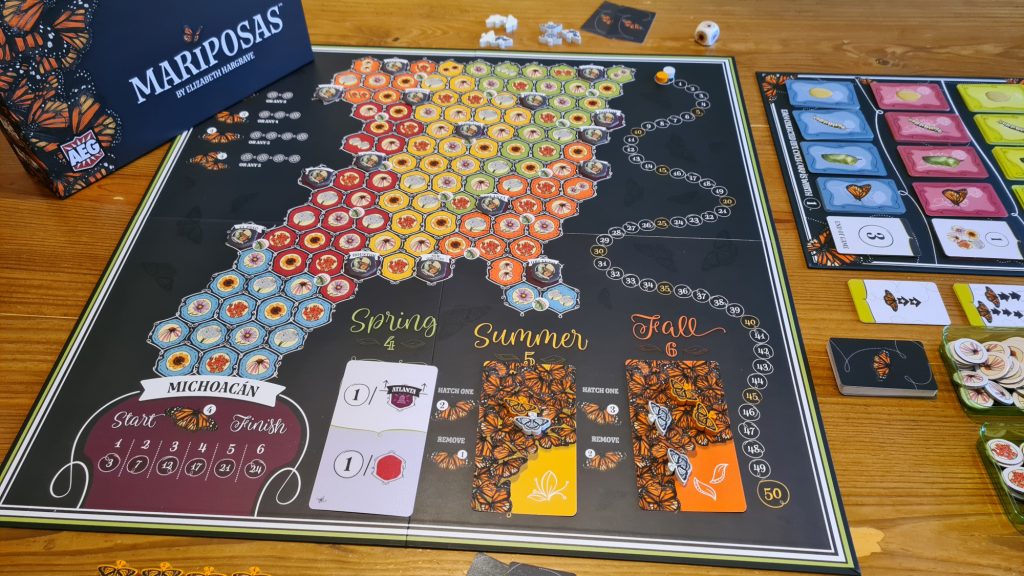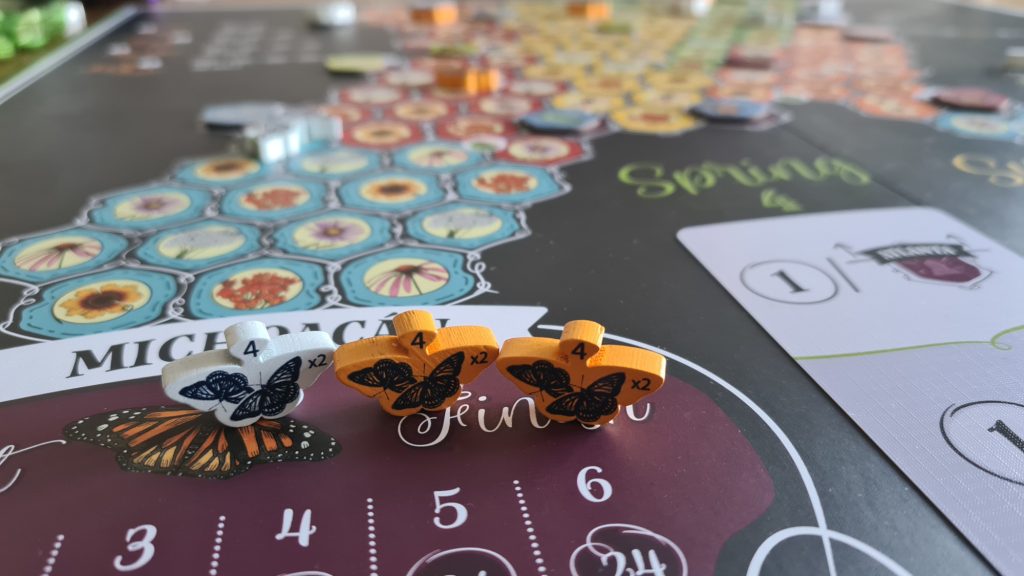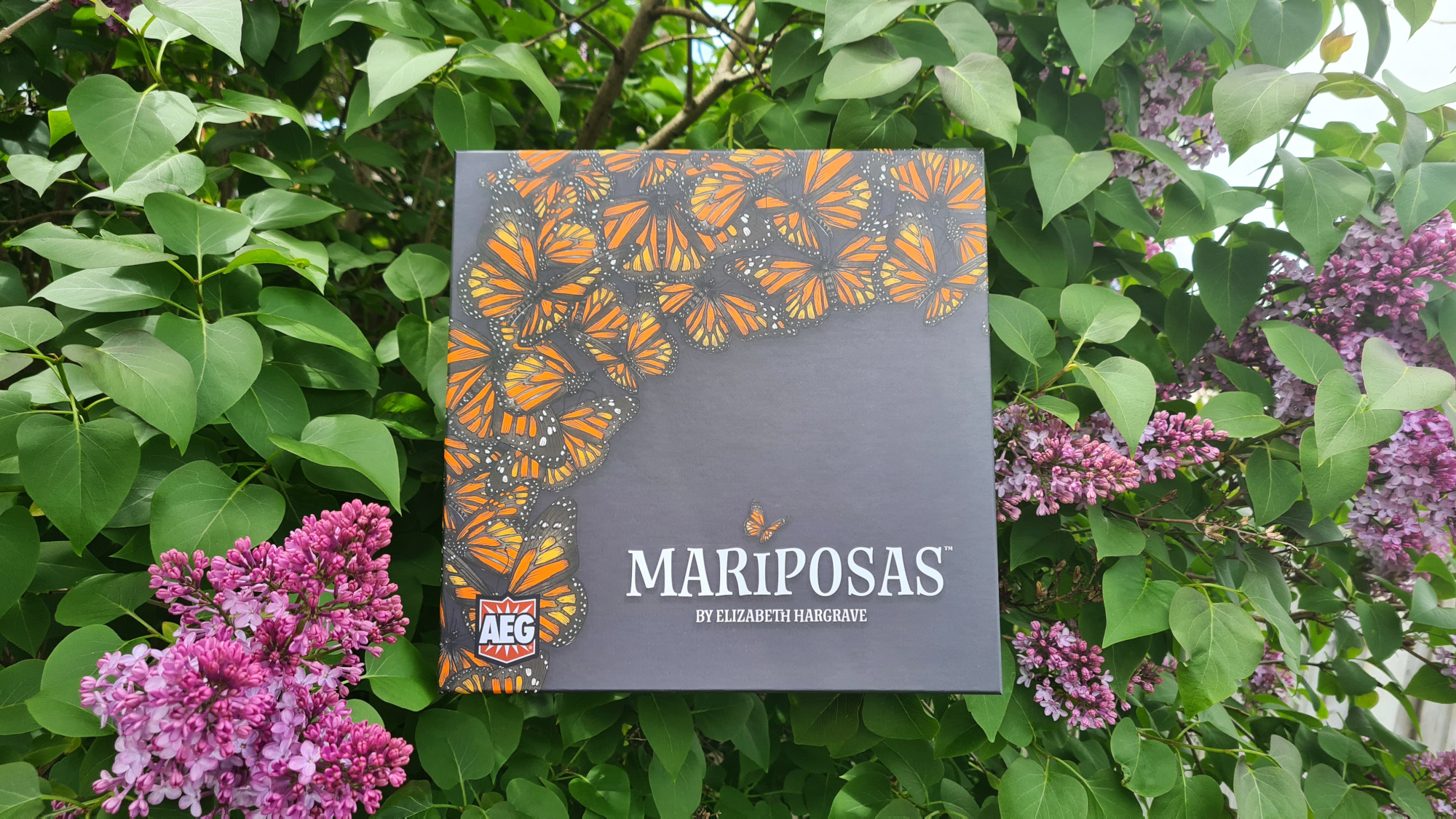Mariposas is the brand new butterfly themed board game from celebrated designer Elizabeth Hargrave, the designer behind the hugely popular game Wingspan. Published by Alderac Entertainment Group, Mariposas sees 2 – 5 players flutter their way from Mexico to the top of North America and attempt to return to Mexico, breeding along the way through Spring, Summer and Fall. With hexagonal grid movement, set collection and movement cards there’s more to the game than just being a family of butterflies. However, should you let this one flutter on by? Let’s find out!
Starting in Michoacan each player places their single generation 1 butterfly onto the board, with the journey across the hexagonal grid of North America above them. Players draw two action cards, with flower tokens sorted into piles, season scoring cards randomly chosen and a number of future generation butterflies placed onto each of these scoring cards by each player. The waystation side board is sorted out, with piles of matching cards and bonus tiles. Then, Mariposas is ready to play.
Each turn players follow a 3 step process, with 2 mandatory actions and one optional action. Players must start by playing one of their two action cards. These action cards allow the player to move their butterflies a set number of spaces. Most of the cards feature two movements, though some offer a single large movement or 3 smaller movements. Choosing any of their butterflies the player moves the piece the number of hexagons indicated on the card. If multiple movements are depicted these can be split between different butterflies, or used on the same butterfly. Individual movements are separate though, potentially both triggering step 2 for the player.
Regardless of the distance moved when a player lands on a space they take the flower token depicted on the space. If a player instead lands on one of the waystation spaces they take the waystation card indicated by the token on the space. If they are first to the waystation they also roll the flower die to receive a bonus flower token. Waystation cards are all worth a point at the end of the game, with bonus opportunities or perks gained by collecting a set of coloured cards.

Dotted across the board are milkweed symbols, adjacent to multiple spaces rather than on specific spaces. When landing on an adjacent space to a milkweed symbol players can hatch a next generation butterfly. Note that this is the optional action, and coming with a cost players may not be able to afford it. Depending on the generation of the landing butterfly the player can hatch a butterfly of the next generation. For example, the generation 1 butterfly can hatch a generation 2 butterfly. The cost each time is equal to the hatching generation if spending matching flower tokens or the generation plus 1 if using any flower tokens – so for a generation 2 butterfly a player could spend 2 matching flower tokens or any 3 tokens.
Each player only has so many butterflies of each generation to hatch, with them first taken from the season scoring cards. Once all the butterflies from a scoring card have been hatched it is revealed, allowing players to gain information early about future scoring phases. The final step of a turn is to draw a new action card, back to the hand of two cards. Play continues to the next player clockwise, with a set number of rounds played each season.
At the end of each season the scoring card for the season, not all revealed scoring cards, is triggered. These are opportunities for players to gain points during the game by fulfilling specific criteria. Ranging from getting butterflies East of Atlanta to having a butterfly in each colour section of the board, players don’t need to go for all objectives but they are worth valuable points! When Fall ends there are additional scoring opportunities. Depending on the number of generation 4 butterflies players get back to Michoacan points are awarded. After this and waystation points are calculated, whoever has the most points wins – with ties broken by the number of butterflies back in Michoacan.
At the end of the game a lot of points are up for grabs for having generation 4 butterflies back in Michoacan, yet the seasonal objectives entice players and pull the butterflies higher or further across the board. This isn’t the only benefit they bring to the experience. The range of seasonal scoring cards, and the bonuses available from collecting waystation sets, provides the much needed variety. Keeping each game that bit different from the last, players will have to determine what objectives they want to try to achieve and the combination of what’s available is rarely the same.

When it comes to player count the game sets a nice balance, though will generally last longer as more players get involved. One aspect that is noticeable at 2 players though is that it is seemingly harder to get the waystation bonuses. With fewer players venturing across the board and landing on waystations to reveal the tokens it’s easier to miss the final station of a colour and not find a full set. It is far from impossible, yet the players sort of have to commit more to finding the set – compared to when they are slowly unveiled by others.
There are a lot of components from the 5 different flower token types, through to the 4 types and 3 colours of waystation cards to collect sets of. These make Mariposas look much more complicated than it actually is. The different token types are effectively the same, aside from collecting sets of the same type. What the waystation cards are also doesn’t matter, just the colour of the items when attempting to collect the set. Once players realise this the game becomes a rather simple one to play when you get going. The game swiftly becomes about the choices of where to move and what to collect and not questions of why do something or not understanding how it all works.
Components wise Mariposas offers a vibrant and decent visual experience, with a nice finish on the cards and the flair of the wooden butterfly pieces. As colourful as the board is though the dark colouring around it, which seems to be going for a modern clean look, doesn’t seem to fit. When you think of butterflies or even the journey it’s about the meadows, grasslands and more they fly through, and this could have brought more life to the board. Putting this aside, it is great to see that token holders are included for the flower tokens, which makes organisation easier and keeps things neater on the table. It’s a bit of a shame that two of the flowers are similar in shape and colour and thus can be misread at a glance – something which isn’t great when trying to collect sets. It’s not game breaking but it is something to be aware of.
Mariposas manages to walk the fine tightrope of having meaningful decisions without overcomplicating the game. On a turn players choose one of the two cards from their hand and move their butterflies. This gives many options later on, whilst keeping the start of the game extremely simple – as players only have one butterfly to move. There is the constant pull up and across North America, whilst you constantly have the knowledge of needing to get some butterflies back to Michoacan, with it being your own fault if you don’t get back in time. Variety is there from the difference scoring objectives and waystation bonuses, allowing the game to remain fresh. It might not be as much of a smash hit as Elizabeth Hargrave’s Wingspan but it’s still a solid game for any collection.
(Editor’s Note: Mariposas was provided to us by Asmodee for the review. The game is currently available from local board game stores! Find your local store here.)

